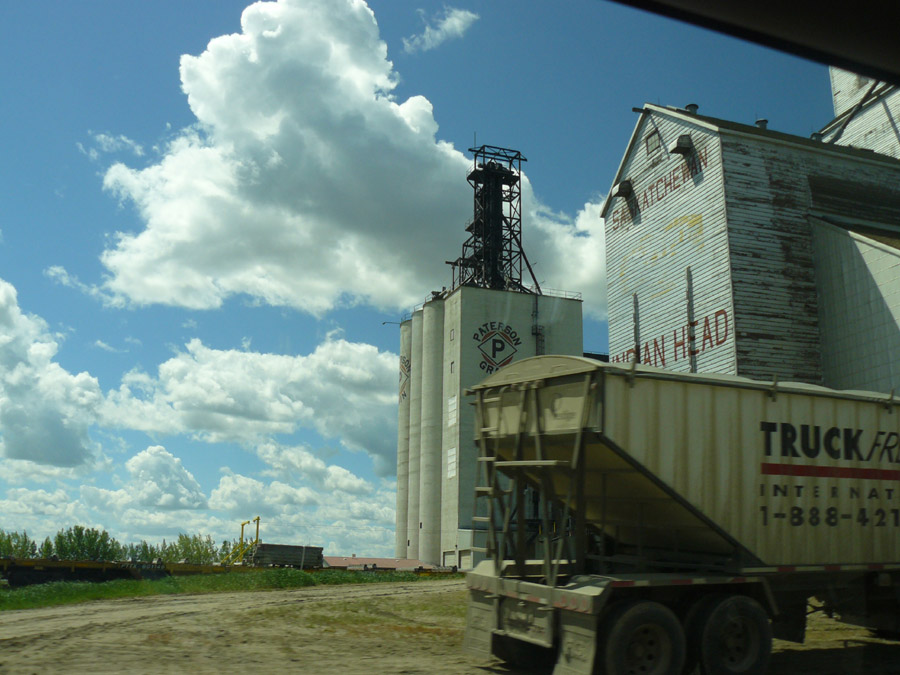 Location Taken: Indian Head, Saskatchewan, Canada
Location Taken: Indian Head, Saskatchewan, Canada
Time Taken: June 2010
I’ve been sorting through more of my photos today, and hit the Great Plains of Canada photos.
So. Many. Awesome. Clouds.
The landscape on the plains tends not to be the most spectacular, being, well, flat. There’s farms here, small batch of trees there, maybe a building or stream. The sky, on the other hand, is fabulous.
In areas like the East Coast, the suburbs, forests, and mountains I spend most of my time in, the sky isn’t too impressive. Mostly, it’s due to the humidity. When the humidity’s high, it blurs distant sight. Mainly, you think of humidity as see-through. I mean, it’s clear water in clear air, right. Well, get enough of it, and the photons just can’t make it all the way to you through it from those distant places. You can think of it as very thin fog, because that’s essentially what it is. Add in the air pollution you find in this area (it’s not too bad, but we’ve got millions living within 100 miles of here, it adds up) and it just degrades the vision some more. There’s a perpetual haze blurring the horizon and the edges of the clouds. Plus there’s enough stuff around that you can’t truly see the horizon. Usually, you can’t even see anywhere close to the horizon, thanks to that building, or those trees. You can see some of that in this picture, how the grain elevator blocks half the sky.
In the plains, though, the air is clear. First, the reason that the plains are, well, plains is that they don’t get enough moisture to support large stands of trees. What trees there are cluster around the rivers, lakes, and ponds, and almost none of those are anything to write home about. Why doesn’t it get moisture? Well, blame the Rockies. (and yes, there are Rocky Mountains in Canada, too. The mountain chain doesn’t stop at the border). I’d say it was the rain shadow effect, where air going over mountains gets compressed and drops all its moisture on one side of the mountain and has nothing left for the other, but its not. At least, not fully. You see, the weather systems coming over the Rockies have already been squeezed dry before they even reached the Rockies. There’s another chain of mountains between the Rockies and the Pacific ocean, after all. And in the Cascade mountains, you can see a clear rain shadow effect. In fact, it’s so strong of an effect that there’s a full out rainforest on one side, in the Vancouver area, and a full-out desert on the other, in the Kamloops area. Those towns are on either side of the mountains, just four hours drive apart. And it’s not a straight drive, either, since there are, you know, mountains in the way. That’s about as far as New York City and Boston are, and those have very similar climates.
So, why aren’t the plains a desert as well? Where’s the moisture coming from, since it’s not really coming over the mountains? The answer, at least for most of the Great Plains, is the Gulf of Mexico. The wet hot air from there actually gets pulled in by the drier air of the plains, dragging it up pretty far north, all the way to the Canada prairie. And the mixing of the two airs causes storms. Violent storms, even. It’s why you get so many tornadoes in the great plains, not to mention thunderstorms.
And it’s why you get fantastic clouds.
Now, I’m not sure if moisture come in from elsewhere for the Canadian prairie. Most of the material on this sort of thing focuses heavily on the lower Great Plains, especially the Tornado Alley section. Canada is, sadly, largely forgotten by the meteorology books I’ve found here, deep within the US. It might pull some moisture from further north as well, or the air might be cool enough that it’s already pretty dense by the time it hits the mountains, and it doesn’t drop as much moisture. Banff, on the eastern edge of the Canadian Rockies, wasn’t exactly the driest place. There’s also a bend in the mountains in Canada, starting a few hundred kilometers north of Kamloops, which may let the moisture get through without hitting so many mountains. The weather patterns actually parallel the mountains in that area some, rather than go perpendicular like you find further south in the US. Either way, the Great Plains actually don’t extend too deeply into Canada, switching over to taiga after half a province. It’s still the breadbasket of the country, just like it is in the US, and it is covered in farms and, in the drier western section, pastures. In Saskatchewan, it’s farms, which is why the tiny town of Indian Head, located on the rail lines, needs a grain elevator.

I really like the color and composition in this piece. I’m also a sucker for clouds.
The only thing that kept this from hitting my “Best” category was that truck in front, which shifted the composition in ways I don’t fully care for. (Yes, I’m picky). That and I really wanted to talk about clouds today, and very few cloud photos hit the “Mid-Range” focus level. (Yes, still picky)
And I was REALLY happy to see that the clouds in the photos came out as eye-catching as the clouds in real life. There’s something about prairie clouds that draws the eyes upwards.